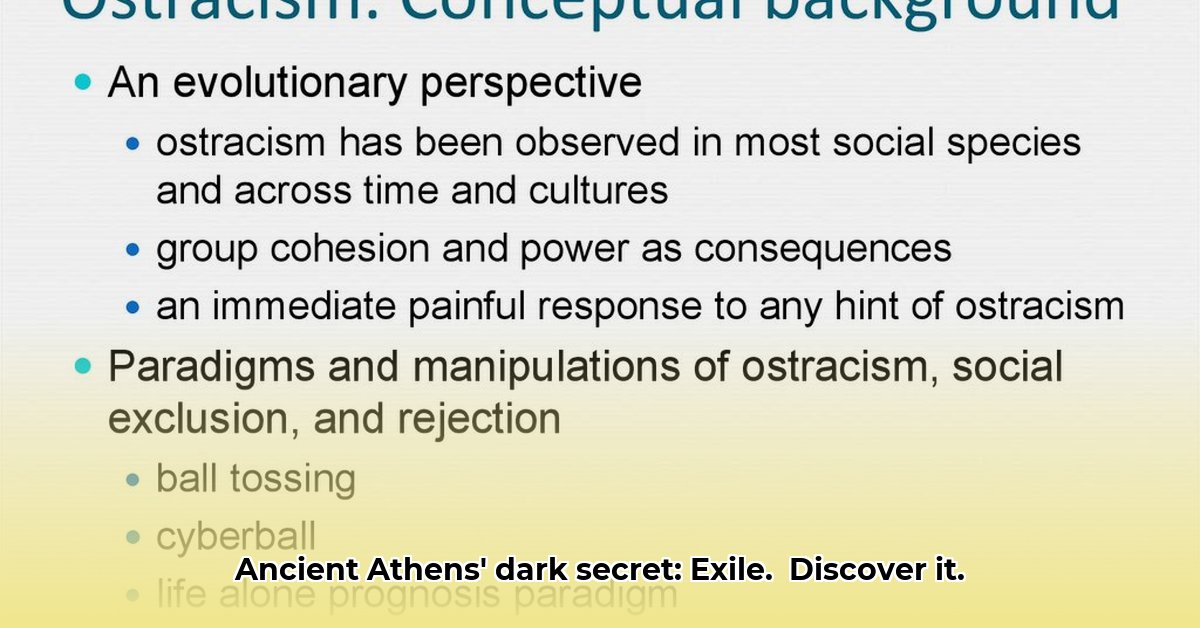Ever wondered about a democracy where citizens could vote to banish individuals simply for being too powerful or influential? That’s precisely what transpired in ancient Athens through a unique political process known as ostracism. This wasn’t about penalizing criminals; it was a mechanism, albeit a drastic one, for maintaining equilibrium within the power structure and preventing the rise of tyranny.
This article provides an in-depth exploration of this captivating system. We’ll guide you through its mechanics, from the initial decision to hold a vote to the eventual exile, examine notable instances, and delve into the central debate: did ostracism genuinely succeed in its aims, or was it prone to abuse? We’ll also consider its limitations, such as the exclusion of women and slaves, and connect the discontinuation of ostracism to the subsequent evolution of Athens’ political landscape.
The Mechanics of Ostracism
The Athenian ostracism process was a structured procedure, implemented annually, involving several key steps:
Step 1: The Preliminary Vote
The process began with a vote in the Athenian Assembly (ekklesia) to determine whether an ostracism should take place that year. This wasn’t an automatic occurrence; citizens had to deem it necessary to consider banishing someone. The assembly, meeting on the Pnyx hill, required a quorum of at least 6,000 male citizens for the vote to be valid.
Step 2: The Ostracophoria
If the assembly voted in favor of holding an ostracism, a special meeting called the ostracophoria was organized in the agora (the central marketplace and public square) on a specific day in the eighth prytany (one of the ten divisions of the Athenian year).
Step 3: Casting the Ballots
During the ostracophoria, citizens cast their votes by scratching the name of the individual they wished to see exiled onto a piece of broken pottery called an ostrakon. The voting was done anonymously. Officials known as phylai collected the ostraka to ensure that no one voted twice.
Step 4: The Count and the Verdict
To be effective, an ostracism required a minimum of 6,000 votes cast in total. The officials then announced the individual who had amassed the most votes. That person was ostracized, meaning they were exiled from Athens for a period of ten years.
Step 5: Exile
The ostracized individual was given ten days to organize their affairs and leave the city. During their exile, they were prohibited from returning to Attica (the region surrounding Athens). A critical point is that ostracism did not result in the loss of citizenship or the confiscation of property.
Notable Cases of Ostracism
Several prominent figures in Athenian history were subjected to ostracism:
- Hipparchus, son of Charmus: Claimed the dubious distinction of being the first recorded exile using this method in 487 BCE.
- Megacles: A member of the Alcmaeonid family, was ostracized in 486 BCE.
- Aristides: Known as “The Just,” was ostracized in 482 BCE but was later recalled to help defend Athens against the Persian invasion.
- Themistocles: The brilliant Athenian statesman and general, was ostracized around 471 BCE after facing accusations of bribery.
- Cimon: A prominent general, was ostracized in 461 BCE amid suspicions of being too friendly with Sparta.
- Thucydides (not the historian): A political rival of Pericles, was ostracized in 443 BCE.
- Hyperbolos: A demagogue, was the last recorded individual to be ostracized, around 417 BCE.
The Great Debate: Was Ostracism Effective?
The effectiveness of ostracism in preventing tyranny is a subject of ongoing debate among historians.
Arguments for Effectiveness
Proponents argue that ostracism served as a crucial safety valve, preventing potentially dangerous individuals from accumulating too much power and threatening the democratic system. By removing these individuals, Athens could maintain political stability and prevent the rise of a tyrant. The early ostracisms, particularly those targeting individuals suspected of pro-Persian sympathies, may have helped solidify Athenian resolve during the Persian Wars.
Arguments Against Effectiveness
Critics argue that ostracism was often manipulated for political gain, with rival factions using it to eliminate their opponents. The case of Hyperbolos, who was ostracized as a result of a coalition between his rivals Alcibiades and Nicias, is often cited as an example of this abuse. Furthermore, ostracism could remove talented and capable individuals from public life, thereby harming Athens’ overall strength and prosperity.
Strengths and Weaknesses of Ostracism
A balanced assessment of ostracism must consider both its strengths and weaknesses:
| Strength | Weakness |
|---|---|
| Prevented potential tyranny | Susceptible to political manipulation |
| Provided a mechanism for resolving political deadlock | Could remove talented individuals from public life |
| Temporary exile, not permanent disgrace | Decisions were irreversible, lacking formal appeals |
| Maintained civic order | Excluded women, slaves, and foreign-born residents from participating in the process |
| Individuals did not lose property or citizenship | The minimum vote count requirement may have been difficult to reach, rendering the process ineffective |
The End of Ostracism and Its Legacy
The last recorded ostracism occurred around 417 BCE. After this, the practice fell out of use, although it remained legally possible until the 4th century BCE. Political rivals turned to other methods of attacking each other, such as the graphe paranomon (a formal accusation that someone’s proposals were unconstitutional).
Despite its eventual abandonment, ostracism remains a fascinating example of ancient Athenian democracy. It highlights the unique challenges and complexities of self-government and raises important questions about the balance between individual rights and the collective good. The concept of ostracism, in its broader sense of social exclusion, continues to resonate in modern society.
- The Accidental Breakthrough: Penicillin’s Discovery and Impact - August 1, 2025
- Medieval Universities: Shaping Modern Academia - August 1, 2025
- The Radium Girls: Workplace Safety Lessons from a Tragic Past - August 1, 2025
















